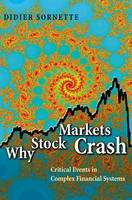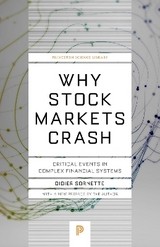
Why Stock Markets Crash
Princeton University Press (Verlag)
978-0-691-09630-8 (ISBN)
- Titel erscheint in neuer Auflage
- Artikel merken
The scientific study of complex systems has transformed a wide range of disciplines in recent years, enabling researchers in both the natural and social sciences to model and predict phenomena as diverse as earthquakes, global warming, demographic patterns, financial crises, and the failure of materials. In this book, Didier Sornette boldly applies his varied experience in these areas to propose a simple, powerful, and general theory of how, why, and when stock markets crash. Most attempts to explain market failures seek to pinpoint triggering mechanisms that occur hours, days, or weeks before the collapse. Sornette proposes a radically different view: the underlying cause can be sought months and even years before the abrupt, catastrophic event in the build-up of cooperative speculation, which often translates into an accelerating rise of the market price, otherwise known as a 'bubble'.Anchoring his sophisticated, step-by-step analysis in leading-edge physical and statistical modeling techniques, he unearths remarkable insights and some predictions - among them, that the 'end of the growth era' will occur around 2050.
Sornette probes major historical precedents, from the decades-long 'tulip mania' in the Netherlands that wilted suddenly in 1637 to the South Sea Bubble that ended with the first huge market crash in England in 1720, to the Great Crash of October 1929 and Black Monday in 1987, to cite just a few.He concludes that most explanations other than cooperative self-organization fail to account for the subtle bubbles by which the markets lay the groundwork for catastrophe. Any investor or investment professional who seeks a genuine understanding of looming financial disasters should read this book. Physicists, geologists, biologists, economists, and others will welcome "Why Stock Markets Crash" as a highly original 'scientific tale', as Sornette aptly puts it, of the exciting and sometimes fearsome - but no longer quite so unfathomable - world of stock markets.
Didier Sornette is Professor of Geophysics at the University of California, Los Angeles, and a research director at Centre National de la Recherche Scientifique, France. A specialist in the scientific prediction of catastrophes in a wide range of complex systems, he is the author of the textbook "Critical Phenomena in Natural Sciences" (Springer-Verlag) and has authored or coauthored more than 300 papers in international journals.
Preface xiii CHAPTER 1: FINANCIAL CRASHES: WHAT, HOW, WHY, AND WHEN? 3 What Are Crashes, and Why Do We Care? 3 The Crash of October 1987 5 Historical Crashes 7 The Tulip Mania 7 The South Sea Bubble 9 The Great Crash of October 1929 12 Extreme Events in Complex Systems 15 Is Prediction Possible? A Working Hypothesis 20 CHAPTER 2: FUNDAMENTALS OF FINANCIAL MARKETS 26 The Basics 27 Price Trajectories 27 Return Trajectories 30 Return Distributions and Return Correlation 33 The Efficient Market Hypothesis and the Random Walk 38 The Random Walk 38 A Parable: How Information Is Incorporated in Prices, Thus Destroying Potential "Free Lunches" 42 Prices Are Unpredictable, or Are They? 45 Risk-Return Trade-Off 47 CHAPTER 3: FINANCIAL CRASHES ARE "OUTLIERS" 49 What Are "Abnormal" Returns? 49 Drawdowns (Runs) 51 Definition of Drawdowns 51 Drawdowns and the Detection of "Outliers" 54 Expected Distribution of "Normal" Drawdowns 56 Drawdown Distributions of Stock Market Indices 60 The Dow Jones Industrial Average 60 The Nasdaq Composite Index 62 Further Tests 65 The Presence of Outliers Is a General Phenomenon 69 Main Stock Market Indices, Currencies, and Gold 70 Largest U.S. Companies 73 Synthesis 75 Symmetry-Breaking on Crash and Rally Days 76 Implications for Safety Regulations of Stock Markets 77 CHAPTER 4: POSITIVE FEEDBACKS 81 Feedbacks and Self-Organization in Economics 82 Hedging Derivatives, Insurance Portfolios, and Rational Panics 89 "Herd" Behavior and "Crowd" Effect 91 Behavioral Economics 91 Herding 94 Empirical Evidence of Financial Analysts 'Herding' 96 Forces of Imitation 99 It Is Optimal to Imitate When Lacking Information 99 Mimetic Contagion and the Urn Models 104 Imitation from Evolutionary Psychology 106 Rumors 108 The Survival of the Fittest Idea 111 Gambling Spirits 112 "Anti-Imitation" and Self-Organization 114 Why It May Pay to Be in the Minority 114 El-Farol's Bar Problem 115 Minority Games 117 Imitation versus Contrarian Behavior 118 Cooperative Behaviors Resulting from Imitation 121 The Ising Model of Cooperative Behavior 122 Complex Evolutionary Adaptive Systems of Boundedly Rational Agents 130 CHAPTER 5: MODELING FINANCIAL BUBBLES AND MARKET CRASHES 134 What Is a Model? 134 Strategy for Model Construction in Finance 135 Basic Principles 135 The Principle of Absence of Arbitrage Opportunity 136 Existence of Rational Agents 137 "Rational Bubbles" and Goldstone Modes of the Price "Parity Symmetry" Breaking 139 Price Parity Symmetry 140 Speculation as Spontaneous Symmetry Breaking 144 Basic Ingredients of the Two Models 148 The Risk-Driven Model 150 Summary of the Main Properties of the Model 150 The Crash Hazard Rate Drives the Market Price 152 Imitation and Herding Drive the Crash Hazard Rate 155 The Price-Driven Model 162 Imitation and Herding Drive the Market Price 162 The Price Return Drives the Crash Hazard Rate 164 Risk-Driven versus Price-Driven Models 168 CHAPTER 6: HIERARCHIES, COMPLEX FRACTAL DIMENSIONS, AND LOG-PERIODICITY 172 Critical Phenomena by Imitation on Hierarchical Networks 173 The Underlying Hierarchical Structure of Social Networks 173 Critical Behavior in Hierarchical Networks 177 A Hierarchical Model of Financial Bubbles 181 Origin of Log-Periodicity in Hierarchical Systems 186 Discrete Scale Invariance 186 Fractal Dimensions 188 Organization Scale by Scale: The Renormalization Group 192 Principle and Illustration of the Renormalization Group 192 The Fractal Weierstrass Function: A Singular Time-Dependent Solution of the Renormalization Group 195 Complex Fractal Dimensions and Log-Periodicity 198 Importance and Usefulness of Discrete Scale Invariance 208 Existence of Relevant Length Scales 208 Prediction 209 Scenarios Leading to Discrete Scale Invariance and Log-Periodicity 210 Newcomb-Benford Law of First Digits and the Arithmetic System 211 The Log-Periodic Law of the Evolution of Life? 213 Nonlinear Trend-Following versus Nonlinear Fundamental Analysis Dynamics 217 Trend Following: Positive Nonlinear Feedback and Finite-Time Singularity 218 Reversal to the Fundamental Value: Negative Nonlinear Feedback 220 Some Characteristics of the Price Dynamics of the Nonlinear Dynamical Model 223 CHAPTER 7: AUTOPSY OF MAJOR CRASHES: UNIVERSAL EXPONENTS AND LOG-PERIODICITY 228 The Crash of October 1987 228 Precursory Pattern 231 Aftershock Patterns 236 The Crash of October 1929 239 The Three Hong Kong Crashes of 1987, 1994, and 1997 242 The Hong Kong Crashes 242 The Crash of October 1997 and Its Resonance on the U.S. Market 246 Currency Crashes 254 The Crash of August 1998 259 Nonparametric Test of Log-Periodicity 263 The Slow Crash of 1962 Ending the "Tronics" Boom 266 The Nasdaq Crash of April 2000 269 "Antibubbles" 275 The "Bearish" Regime on the Nikkei Starting from January 1, 1990 276 The Gold Deflation Price Starting in Mid-1980 278 Synthesis:"Emergent "Behavior of the Stock Market 279 CHAPTER 8: BUBBLES, CRISES, AND CRASHES IN EMERGENT MARKETS 281 Speculative Bubbles in Emerging Markets 281 Methodology 285 Latin-American Markets 286 Asian Markets 295 The Russian Stock Market 304 Correlations across Markets: Economic Contagion and Synchronization of Bubble Collapse 309 Implications for Mitigations of Crises 314 CHAPTER 9: PREDICTION OF BUBBLES, CRASHES, AND ANTIBUBBLES 320 The Nature of Predictions 320 How t Develop and Interpret Statistical Tests of Log-Periodicity 325 First Guidelines for Prediction 329 What Is the Predictive Power of Equation (15)? 329 How Long Prior to a Crash Can One Identify the Log-Periodic Signatures? 330 A Hierarchy f Prediction Schemes 334 The Simple Power Law 334 The "Linear" Log-Periodic Formula 335 The "Nonlinear" Log-Periodic Formula 336 The Shank 's Transformation on a Hierarchy of Characteristic Times 336 Application to the October 1929 Crash 337 Application to the October 1987 Crash 338 Forward Predictions 338 Successful Prediction of the Nikkei 1999 Antibubble 339 Successful Prediction of the Nasdaq Crash of April 2000 342 The U.S. Market, December 1997 False Alarm 342 The U.S. Market, October 1999 False Alarm 346 Present Status of Forward Predictions 346 The Finite Probability That No Crash Will Occur during a Bubble 346 Estimation of the Statistical Significance of the Forward Predictions 347 Statistical Confidence of the Crash "Roulette" 347 Statistical Significance of a Single Successful Prediction via Bayes's Theorem 349 The Error Diagram and the Decision Process 351 Practical Implications on Different Trading Strategies 352 CHAPTER 10: 2050: THE END OF THE GROWTH ERA? 355 Stock Markets, Economics, and Population 355 The Pessimistic Viewpoint of "Natural" Scientists 357 The Optimistic Viewpoint of "Social" Scientists 359 Analysis of the Faster-Than-Exponential Growthof Population, GDP, and Financial Indices 361 Refinements of the Analysis 369 Complex Power Law Singularities 369 Prediction for the Coming Decade 371 The Aging "Baby Boomers" 377 Related Works and Evidence 378 Scenarios for the "Singularity" 383 Collapse 384 Transition to Sustainability 389 Resuming Accelerating Growth by Overpassing Fundamental Barriers 393 The Increasing Propensity to Emulate the Stock Market Approach 395 References 397 Index 419
| Erscheint lt. Verlag | 8.12.2002 |
|---|---|
| Zusatzinfo | 10 halftones. 155 line illus. 21 tables. |
| Verlagsort | New Jersey |
| Sprache | englisch |
| Maße | 152 x 235 mm |
| Gewicht | 794 g |
| Themenwelt | Wirtschaft ► Betriebswirtschaft / Management ► Finanzierung |
| ISBN-10 | 0-691-09630-9 / 0691096309 |
| ISBN-13 | 978-0-691-09630-8 / 9780691096308 |
| Zustand | Neuware |
| Informationen gemäß Produktsicherheitsverordnung (GPSR) | |
| Haben Sie eine Frage zum Produkt? |
aus dem Bereich



